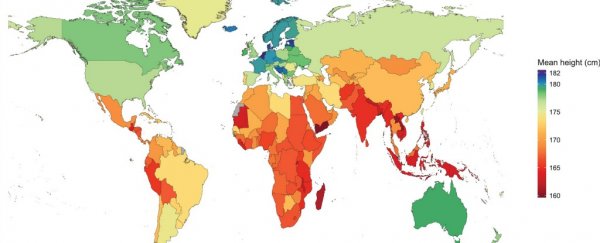In a global height analysis based on nearly 1,500 studies, Dutch men and Latvian women topped the charts, standing tallest at heights of 182.5cm and 169.8cm on average respectively.
The study found heights have changed dramatically between 1914 and 2014, with South Korean women showing the largest increase of 20.2 cm over the period.
Americans are leading the race in another trend - plateauing. The study shows that although humans as a species are still getting taller, countries such as the US, UK, and Japan have stopped or slowed growing significantly in the last 30-40 years.
The US, once home to the 3rd tallest men and 4th tallest women in the world, are now sitting in 37th and 42nd place respectively.
"This study gives us a picture of the health of nations over the past century, and reveals the average height of some nations may even be shrinking while others continue to grow taller," said lead researcher Majid Ezzati from Imperial College London in the UK.
"Our study also shows the English-speaking world, especially the USA, is falling behind other high-income nations in Europe and Asia Pacific. Together with the poor performance of these countries in terms of obesity, this emphasises the need for more effective policies towards healthy nutrition throughout life."
Although part of the height difference can be attributed to genetics, the height increase is likely due to nutrition, hygiene, and healthcare – factors that influence whether people are reaching their height potential.
"An individual's genetics has a big influence on [their] height … but once you average over whole populations, genetics plays a less key [role]," one of the researchers, James Bentham, told Nicola Davis at The Guardian.
"Most populations would grow to roughly similar heights if they were all in the same conditions."
So where does your country sit in regards to heights, then and now? The researchers have put together an interactive world map to show how our heights have changed. There's also a full list of rankings for males and females in the 200 countries studied.
Most of the top countries for height are European countries, with Australia being the only country not in Europe to be inside the top 25.
The news isn't all good – some countries, particularly those in sub-Saharan Africa, North Africa, and the Middle East, have seen a decline in the average height in the last 30-40 years.
"This confirms we urgently need to address children and adolescents' environment and nutrition on a global scale, and ensure we're giving the world's children the best possible start in life," said Ezzati.
The study gives an interesting insight into how we have changed over the last 100 years – a time before teenager was a word, over half the US population lived in rural areas, and modern medicine was just getting off the ground.
"This is a unique analysis that shows the real power of combining a hundred years of population data sources that span the globe," said Mary De Silva from the Wellcome Trust, who wasn't involved in the study.
"The most striking finding is that despite the huge increases in height seen in some countries, there is still a considerable gap between the shortest and tallest countries. More research is needed to understand the reasons for this gap and to help devise ways of reducing the disparities in health that still persist globally."
The study was published in eLife.
